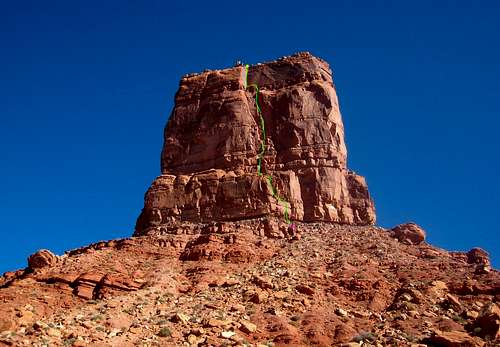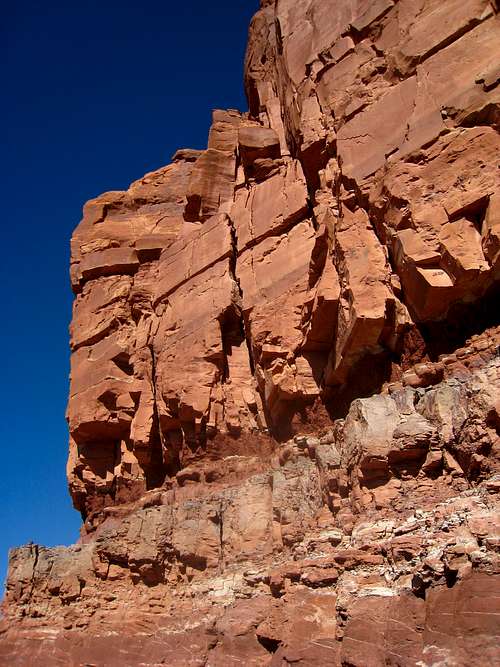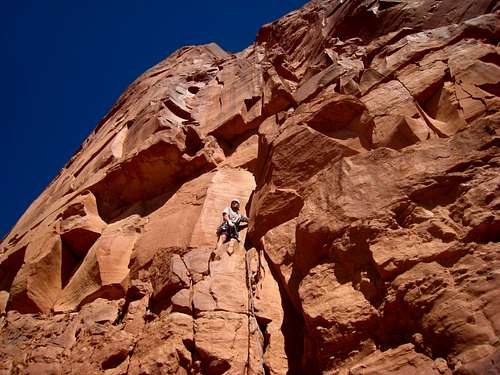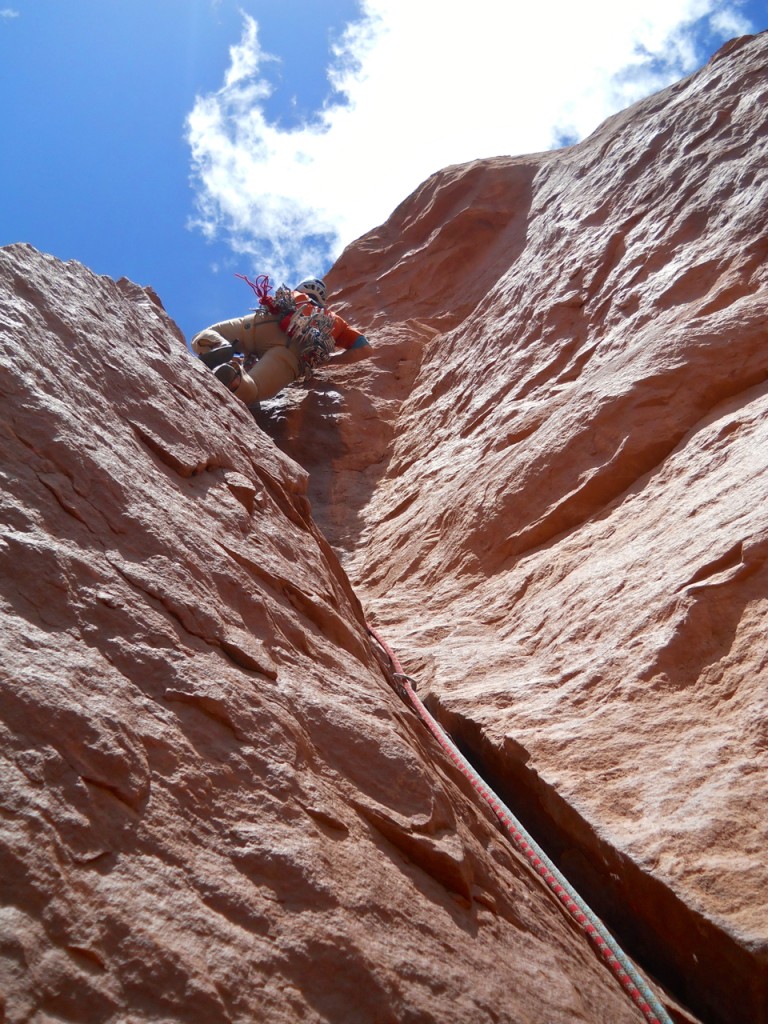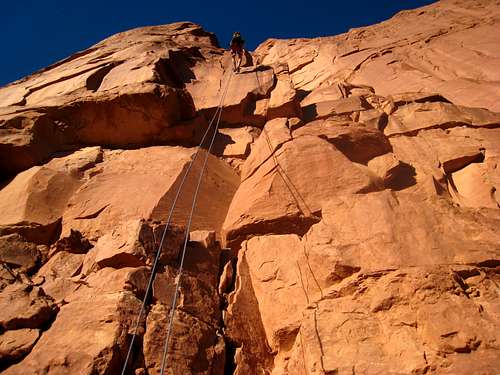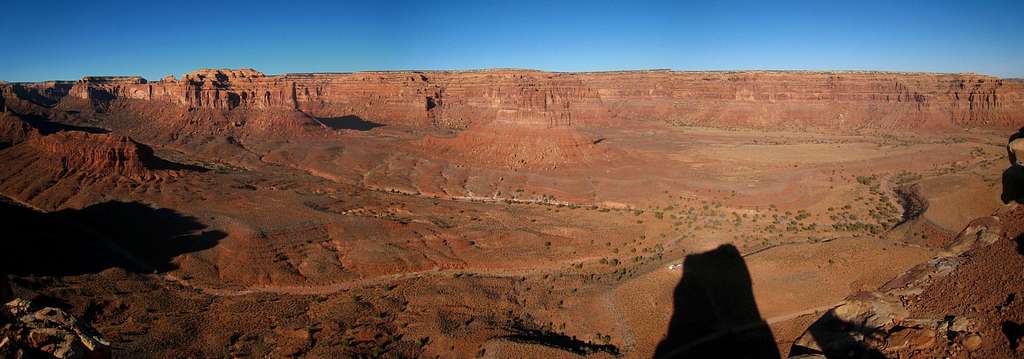-
 3286 Hits
3286 Hits
-
 79.45% Score
79.45% Score
-
 11 Votes
11 Votes
|
|
Route |
|---|---|
|
|
37.31389°N / 109.85395°W |
|
|
Trad Climbing |
|
|
Spring, Fall, Winter |
|
|
Half a day |
|
|
5.10b (YDS) |
|
|
5 |
|
|
III |
|
|
Overview
This is a great route with superb climbing. Five short pitches totaling about 340 feet of climbing take you to the narrow and exposed summit. Since it's on the sunny south face, climb this route in winter sometime for complete solitude! The first pitch has the only poor rock on the route and has some off-width thrashing while the upper four pitches offer various types of climbing from thin finger cracks, thin hand cracks to some chimney climbing. The crux of the route is at the end of the second pitch where a 10 foot thin finger crack guarded by a small overhang takes you to the second belay ledge.
Getting There
Park at a small pull-out along the Valley of the Gods Road shortly after the road crosses a small dry wash (if coming from the east side of the loop). You should be able to see the entire south face head on and the route is the obvious cleft cutting down the middle of the face. Begin hiking straight towards the face and cross the small dry wash. Work your way up the 300 foot talus cone on the path of least resistance. Lots of loose rock is found but the approach is short and takes only 20 minutes or so.
Route Description
| Pitch | Photo | Rating | Description |
| 1 | 5.8 | The first pitch starts just to the right of center of the south face and heads up the obvious off-width pod and up the dirty 5.8 wide crack to a small ledge. You can continue up the 5.7 off-width chimney from the small ledge right to a bunch of slings marking the final rappel anchor. If you don't want to thrash your way up the chimney, you can traverse a few feet left and continue up a left facing 5.8 dihedral with a wide hands crack (and more rope drag). The final move has a chicken wing and mantle to the big ledge. Once on the huge ledge, make an anchor in one of the solid cracks on the wall rather than using the slings at the top of the chimney. This is the longest pitch on the route at around 90 feet. The remaining pitches are all about 50-60 feet long. | |
| 2 | 5.10b | The second pitch starts up an easy chimney to a short thin hands crack. Above that, mantle onto a tiny ledge and traverse a few feet right until right below a thin finger crack. This is the crux of the route although it is short. Work your way onto the finger crack by surmounting a small overhang and climb 10 feet to a large ledge with two solid pitons. This marks the second belay ledge. | |
| 3 | 5.9 | The third pitch heads up the obvious chimney crack above the belay ledge. This pitch is fairly dirty but not as bad as the first pitch. Smear and jam you feet on the many features available while keeping your hands as solid as possible. The hand and fist jams aren't great. Top out onto a small ledge with an excellent anchor consisting of three or four pitons and plenty of slings. | |
| 4 | 5.10a | The forth pitch climbs an excellent, solid thin hands crack. Start just above and to the left of the belay and climb the dihedral crack which has a tough start. At first the crack is sub-vertical but ends at a short overhang before you emerge onto a bedding seam where the rock deteriorates and the climbing eases significantly for a few feet. Scramble up a loose 15 feet to the large ledge at the base of the final pitch. Add a sling to the double piton anchor and belay. I thought this was the hardest pitch as it was sustained 5.10 climbing and my big hands made it much harder.Note that the third and forth pitches are commonly combined | |
| 5 | 5.9 | The final pitch climbs the stellar and obvious right facing dihedral for 50 feet to the summit. Although it's rated 5.9 I felt the start was a little harder. Thin hands at the beginning lead into better hands and enough features for your feet for good rests. The final mantle onto the summit will suck the remaining energy you might have. Enjoy the beautiful summit! |
Descent
Descending the route is actually fairly simple. With a 70 meter rope there are three rappels. Locate a bunch of slings around one of the large blocks about 10 feet to the right of where you topped out on the summit. This is the first rappel. Make a long rappel to the bomber anchor at the top of the third pitch. Don't rappel from the pitons at the base of the final pitch. Make a second long rappel to the huge ledge atop of the first pitch. Finally rappel the first pitch using the slings at the top of the chimney. This rappel has an awkward start and squeezing through the chimney can be a challenge.
Required Gear
Bring a double rack of BD Camelots from 0.3 - 3 inches. Also have some smaller stuff like Metolius 0-1 Mastercams. Helmets are a must. 70 meter rope
Summit View
External Links
Eagle Plume on Mountain Project
Castle Butte (Eagle Plume Tower) on Lists of John


